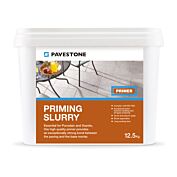Why Use Slurry Primer?
In this guide we will explain what is a slurry primer, why you should use slurry primer for patio installation, why you must use it for porcelain installations, and how to mix and then apply it to your slabs when installing patio paving.
Looking to buy? We stock high-quality priming slurry.
What is slurry primer?
A slurry primer (aka bond bridge, primer, slurry coat) is painted onto the underside of paving immediately prior to laying. Its function is two-fold:
- Bonding – slurry primer improves bonding/adhesion between the paving and the laying course (bedding mortar)
- Barrier – priming slurry helps prevent leaching/osmosis of moisture, mineral salts and other cementitious materials from the laying course up into the paving above.
Priming slurry can also be used to help bond the following and ensure they remain firmly fixed in place:
- Coping stones
- Pier caps
- Steps
- Ornamental columns and pillars (sundials, statue bases etc)
Why use priming slurry?
We recommend using a priming slurry for all types of paving slab installations. Different types of paving requiring the priming slurry for different reasons:
Slurry Primer use for non-porous (impermeable) paving slabs
A priming slurry must always be used when installing porcelain paving. It will also be necessary for all natural stone with low porosity (such as slate and most types of granite or igneous rocks).
Porcelain paving is vitrified (like glass). It is ostensibly homogenous, and lacks the microscopic capillaries found in porous materials like sandstone and concrete. This porosity and capillaries are what usually allows the bedding mortar/cement to penetrate and bond with porous stone or concrete.
However, because porcelain is to all intents-and-purposes completely impermeable (non-porous) this porous cement-bonding does not occur. When porcelain paving slabs are laid onto a mortar bed, the concrete bedding mix does not penetrate or get absorbed into the underside of the slab. This prevents the cement forming a strong bond.
This is where a slurry primer is needed. It acts as a glue between the laying course (mortar bed) and the porcelain paving slabs (also true of low porosity granite or slate).
The slurry primer will give you a proper bond and ensure the slabs don’t come loose. This will give your patio much greater strength and durability.
That bond will ensure slabs don’t come loose and rock when walked on. So long-term, it will help reduce trip-hazard issues. The slabs will be securely bonded to the bedding layer beneath.
For home owners and landscapers alike, knowing that the paving is securely bonded to the laying course the main reason to use slurry primer when laying porcelain or low-porous stone.
Slurry primer use for porous (permeable) paving slabs
Sandstone, limestone and concrete slabs are porous. Their structure is filled with tiny capillaries that allow moisture and water to be transpose through the slabs. Consequently, this means that when moisture is present, materials can be conveyed by these capillaries via osmosis and capillary action. In this way, mineral salts, ferrous deposits and other cementitious material from the bedding mortar can be lifted up through the slab to stain the surface (once the moisture evaporates).
Using a priming slurry will help prevent the transfer of moisture from the laying course up through into the slabs.
The slurry primer will also ensure that slab is fully bonded to the bedding mortar. Some landscapers will occasionally use a wetter bedding mortar to exploit the stones porosity to increase bonding. However, this then creates a greater risk of moisture transfer related staining on the slabs surface. So it is better to use priming slurry and a dry-ish mortar bed mix. This combination will ensure optimal bonding and reduce the risk of moisture staining.
Priming slurry also helps prevent differential curing with concrete slabs. As concrete is essentially a chemically-bonded structure that hardens and cures over a long period, when most concrete slabs are laid they have not fully cured (a process that can take many months). Slurry primer reduces the transfer of moisture from the laying course into the still curing slabs. Without slurry primer, it is much more likely that moisture transfer (especially from bedding mortar that is too wet) will create different curing rates between where moisture is present and absent. When this differential curing occurs this can create a staining that appears as weathering on the freshly laid paving.
Advice for using priming slurry when installing your paving
Some general tips and advice when using a slurry primer:
Mixing the slurry
- Follow the mixing and application instructions on the packaging or container to get the exact amount of water and consistency needed
- Use a clean measuring jug to gauge the right amount of water
- Use fresh clean water
- Mix the slurry away from areas where any potential spills and spray/droplets are unwanted
- Use a mixing paddle to mix the powdered slurry with the recommended amount of water
- Clean your mixing paddle to prevent the slurry setting on it.
Applying the priming slurry to the paving slab
- Priming slurry should be applied to the slab just just prior to laying it using a paintbrush
- Use a medium size paintbrush (3” to 4”) to apply the priming slurry
- Don’t overload your brush to avoid running and droplets
- Only apply the priming slurry to the underside of the slab
- If you do get the slurry on the sides or surface of the slab, immediately clean this off (do not let this set)
Avoid spills & clean surfaces and equipment immediately
- Priming slurry is an adhesive/bonding agent, so just like glue if you get it on surfaces it was not intended to be on, it can be very difficult to remove once dried
- Ensure you protect paving, brickwork and other surfaces from spills and splashes
- Immediately clean down any spills or splashes (as once dry, you’ll find removing priming slurry very difficult).
Clean your tools and equipment
- Clean your tools and equipment as soon as you can, because if they become marked with splashes or sprays and you let the priming slurry set, you’ll find it very difficult to remove.
We stock high-quality slurry primer that helps you achieve the best results when laying paving slabs.






